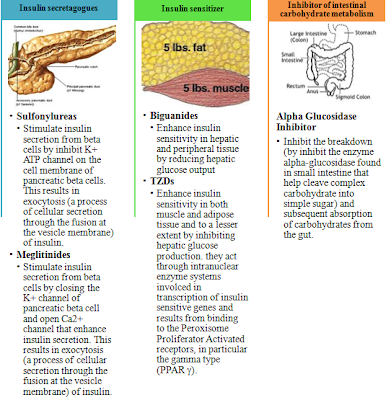ORAL ANTI-DIABETIC AGENTS (ODA)
What is an oral
anti-diabetic agent?
Oral
anti-diabetic agents (ODA) are a class of recommended medication used to
control diabetes. Oral means ‘taken through the mouth’. Usually, it is designed
to help in controlling blood sugar in diabetes type 2 as in diabetes type 1 and
gestational diabetes, the treatment always by using insulin injection.
Classification
of oral anti-diabetic agents.
There are five
classes of oral anti-diabetic agents (table
1):
- Sulfonylureas. It become a backbone in diabetes treatment since early 1950s. The first generation quickly fell out of favor due to increase in mortality secondary to cardiovascular event and supported by the study of the University Group Diabetes Program (UGDP). The second generation becomes more favorable side effect profiles and contribute to their popularities
- Meglitinides. A new non-sulfonylurea insulin secretagogue agent. The time of onset of action is quicker than sulfonylureas and duration of action is shorter.
- Biguanides. It needs insulin to work, do not stimulate insulin release and not primarily insulin resistance lowering agents.
- Thiazolidinadiones(TZDs).In March 2000, the U.S. Food and Drug Administration(FDA) asked the manufacturer (Parke-Davis, Warner-Lambert) of troglitazone, the first agent in this class to receive labeling approval, to remove the product from the market due to 60 reports of severe liver toxicity.
- Alpha glucosidase inhibitor.
Mechanism of
Action
Mechanism of
action means that how the agents react in order to control the glucose level in
diabetic patients. It is classified based on the primary site of action of the
drug. There are three major categories of the drug action:
The table below
shows the classification of the drug based on their primary site of action.
Monotherapy and Combination Therapy
Table 2 below show the possible options in the uses of the five classes of
Oral Atidiabetic Agents based on the target population.Monotherapy is the uses
of single agents in a treatment.
However, if adequate control is not obtained with theuse of a single agent
(monotherapy), combination therapy is an option. Several of the availableoral
agents have been studied in combinationand have been shown to further
improveglycemic control when compared to monotherapy.As with monotherapy, the
choice ofa second agent should be based on individualcharacteristics.
Reasonable combinations ofagents are shown in Figure 2.
The table below shows
the typical doses, side effects and precautions need in a usage of oral
anti-diabetic drugs.
Adapted from © 2006 The
Diabetes Center, Old Saybrook, CT.
For more explanation, you may look at the video below.
sources: medical Nutrition Therapy Guideline for Type 2 Diabetes


























There are recurrently not doctors that take scheduled visits. College health centers help to keep disease and illness under control on a college campus. applebee's for diabetic
ReplyDelete